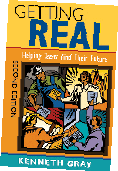 |
Kenneth Gray
Corwin Press
196 pages. $25.95.
As an outspoken advocate of career education and alternatives to four-year college degrees, Gray commands attention: The “goal of getting as many teens as possible to enroll in higher education … allows society to turn [its] back on half the young adults in America.”
“There is a colossal mismatch between the labor force needs … and the skills of the country’s youths,” he says.
As professor emeritus in the Workforce Education and Development Program at Pennsylvania State University and a former high school teacher and guidance counselor, Gray delivers hard truths about the dilemma facing young people entering the work force. Although we notice college graduates taking nonprofessional jobs or moving back home, we still believe that the only route to a good job is a bachelor’s degree – even for students with poor academic credentials, motivation or career plans. Now that 85 percent of all high school graduates enter college, half of them drop out or fail. When successful college graduates search for employment, competition is fierce for the few professional jobs available – only 10 percent of all openings in the American workplace. For half of each year’s college graduates, professional positions do not exist.
Meanwhile many high-paying jobs go begging: skilled technician occupations in industries such as aerospace, electronics, and construction that require a two-year, technical college degree. These plentiful jobs comprise 29 percent of available work, nearly three times as much as the professional segment.
To prepare our youth for the job market, Gray calls for schools to offer career education: Starting in middle school, students develop individual career plans with parents’ input. By 10th grade, they identify tentative career goals in order to choose high school courses and plan fitting post-secondary education – rather than bachelor’s degree programs for nearly everyone. Those who begin working after high school graduation benefit by career and technical education (CTE), which engages many who would otherwise drop out.
Gray describes alternatives to the bachelor’s degree, such as one-year certificates, two-year degrees, apprenticeships, the military, private career schools and a bridge year to prepare for further education. For parents and teens, he offers a “six-step plan for postsecondary success.” He exposes deceptive messages that adults use to soothe anxious teens who don’t know what to do with their lives, such as: “All will become clear in college.” If teachers, counselors and parents are unwittingly setting young people up for failure, it’s time to heed Gray’s compelling advice on “getting real.” (800) 233-9936, http://www.corwinpress.com.





























